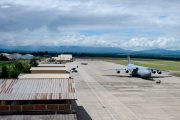Thirty-three miners, who were trapped some 2,300 feet underground in northern Chile since August 5 when the main access tunnel collapsed where they had been working, have been informed they may not be rescued until December.
The miners, ages 19-63, had been surviving on the small amount of rations stored in their 540-square-foot emergency shelter, their fate unknown for 17 days, when finally on the morning of August 22, an eighth rescue probe relayed sounds of tapping on the metal pipe. Four hours later, a bag containing two notes was sent to the surface. “We are fine inside the shelter,” read one of them, “the 33 of us.” Until that point, said rescue team member Dr. Sergio Aguila, “They had two little spoonfuls of tuna, a sip of milk and a biscuit every 48 hours.”
Since then, efforts at the San Jose mine have turned toward rescuing the miners and keeping them mentally and physically healthy. They were informed on August 25 that it may be about 90 days until they can be brought to the surface. Officials said the news was accepted calmly and that the miners were warned that they might suffer “a period of depression, anguish and severe malaise” in the coming days. According to CNN, “Three or four of the miners are showing signs of anxiety and depression.” Jimmy Sanchez, the youngest trapped, is said to be afraid of the dark. Until the time of their discovery, the miners have used truck batteries to help with lights and recharge their helmet lamps.
Said aolnews.com, “Speaking to the men via a microphone lowered into the mine, Chilean President Sebastian Pinera promised to reunite the workers with their families. ‘Mr. President,’ said the miners’ leader, Luis Urzua, according to the BBC, ‘we need you to be strong and to rescue us as soon as possible. Don’t abandon us.’”
President Pinera responded, “You will not be left alone, you have not been alone. The government is with you all, the entire country is with you all.” Their successful discovery brought immediate joy both to family members on-site, and to the entire nation which erupted with cheers and honking horns in the streets.
CNN continued:
Doctors have given the men advice about how to keep their limited living space clean: Portions of a 131-foot-long (40-meter) shaft are being used as a latrine. The shaft is connected to the main 538-square-foot (50-square-meter) cabin, which is being used for sleeping, washing and praying.
The men have split into two shifts so half can rest, while the others keep busy doing tasks, exercising or playing card games or dominoes. Stretchers that were stored in the rescue cabin are being used as beds.
The rescue shelter was stocked with a first aid kit, rubbing alcohol, medicines, deodorant, toothpaste and other necessities.
The men’s sole lifeline to the outside world is a tube about 3.2 inches (8 centimeters) in diameter, through which food, water, clothing, video and radio equipment and whatever else is needed are stuffed. It takes 20 minutes for objects to make the trip.
Initially, the miners survived by draining water from a water-cooled piece of equipment. To stay hydrated in the 85-degree Fahrenheit (29 Celsius) heat, each miner must drink eight or nine pints (4 liters) of water per day.
Doctors and officials are feeding the men carefully, making sure they are properly nourished while seeing to it that all will be slim enough to fit into the 24-inch-wide (60 centimeter) rescue shaft being drilled for them.
A social structure has formed, officials said. A shift leader at the San Jose copper and gold mine is fulfilling a leadership role, and another man with nursing experience is carrying out basic medical and psychological tests.
They hold daily meetings and make decisions by consensus, according to a video the men sent to the surface Thursday.
Maintenance mechanics among them have helped organize the space.
Chilean’s Health Minister Jaime Maalich said rescue workers had managed to finish a second narrow borehole “which would be dedicated to channeling drinking water to the miners and keeping communications flowing.” Clothing is also being sent, as well as medications and antidepressants. The miners have sent up samples of water from their underground tanks for testing. The rescuers have sent down fortified mineral water. Officials are attempting to set up special lighting for the men to simulate night and day, with dull red lights to help with sleep. The Chilean government has consultedwith both NASA and its own submarine navy to discern the best ways of helping the miners cope with their long period of enforced containment. On August 26, the government released five minutes of a video shot by the miners of themselves and their environs, which ended with “a hearty rendition of the Chilean national anthem.”
With the shutting down of work due to the cave-in, the mining company is facing bankruptcy and the men may not be paid, something being kept from them at the moment. Concerning the mine itself, officials say it has a poor safety record and a history of violations. ABC News related:
Senator Baldo Prokurica, a member of Chile’s Senate mining commission, said that the two owners of the mine pushed exploitation beyond safe standards. He said that the five miles of tunnels inside the main shaft of the mine are like “Swiss cheese.”
The main shaft of the gold and copper mine runs like a corkscrew under a mountain in Chile’s Atacama Desert. Standard rock separation between a mine’s various levels is typically 12 meters. In the main shaft of the mine where the August 5 collapse occurred, the levels were separated by a mere 8 meters, making the mine extremely unstable.
A U.S. expert told ABC News that Chile’s mine safety record is better than that of the United States, but Chile’s president has fired a number of senior mine safety officials and promised to pursue criminal charges in the wake of the mine collapse.
Meanwhile, as much free and unfettered communication is being allowed the men and their families as possible. Family members have set up their own area of plastic tents at the mine called Camp Hope and take turns being present while the rescue mission is underway. The men have requested a few holy statues be lowered to them. Esteban Rojas promised his wife he would finally buy her a wedding dress when he got out, and hold a church ceremony, 25 years after they wed in a registry office.
Photo of trapped miners: AP Images


